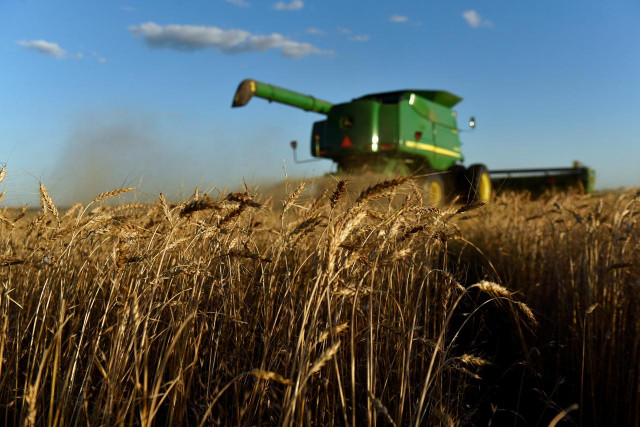Pak-China agri-cooperation and way forward
Focus of all measures should be on people’s livelihood, small farmers and poverty reduction

Agriculture is one of the seven pillars of the long-term China-Pakistan Economic Corridor (CPEC) plan.
It has been agreed that both countries will work on enhancing cooperation in the agriculture sector. The cooperation plan got real impetus after the visit of Prime Minister Imran Khan to China in November 2018.
He asked the Chinese leadership to pour capital into the sector. A memorandum of understanding (MoU) was also inked during the trip to shape future cooperation in the field. It led to the signing of a comprehensive framework for collaboration in May 2019.
An understanding reached to tackle the foot and mouth disease in livestock was another effort to enhance cooperation. An MoU, signed in March 2020 during the visit of Pakistan President Arif Alvi to China, was the most multidimensional and comprehensive.
Under the understanding reached, the areas where the two sides will work jointly include technology transfer, collaboration in research and development, enhancing agricultural trade, cooperation in agro-industry as well as in livestock and dairy.
Every area has its own dynamics and importance for Pakistan. Unfortunately, the South Asian nation is lagging behind in all these areas. It is badly in need of investment in these fields.
Both governments have decided to cooperate and develop the sector. Although investment and cooperation will be expanded at the national level, marginalised and less-developed areas will get priority.
Thus, southern Balochistan has been identified as a priority area and different projects are in the planning phase for this region.
Cooperation has already begun and both governments are making efforts to establish eight research centres for joint research across Pakistan. These research units and laboratories will be equipped with state-of-the-art machinery and technology.
Each research centre will take care of specific research areas according to needs of Pakistan. Through this partnership, Pakistan will also benefit from technology transfer. It will give a chance to the country to venture into new areas of technological development.
China will also offer scholarships to Pakistani students for agricultural study in China. It has also been decided that China will provide skill development opportunities through agricultural vocational training institutes in the country.
Low productivity, exports
Both countries have agreed to work together to produce high-quality inputs, especially seeds, which are direly needed in Pakistan.
It is a well-known fact that productivity of all crops is very low in Pakistan. Average yield of major crops including wheat, cotton, rice, maize and sugarcane is 2.26, 1.87, 2.88, 1.77 and 48.06 tons per hectare respectively.
It is even lower than the productivity of progressive farmers in the country. A major contributing factor is the lack of research in the field.
Export of agricultural commodities is another area of concern for Pakistan. The sector is facing numerous challenges to its attempts aimed at enhancing exports.
Major impediments include a lack of processing facilities, refrigerated transport, cold storage facilities, knowledge of hygiene standards and certification of products.
Transportation and cold storage facilities are in a shambles and Pakistan features among countries where the supply chain is only 20% mechanised, according to a report of the International Food Policy Research Institute (IFPRI).
A lack of refrigerated transport and cold storage hinders the export of agricultural commodities as most of them are perishable in nature.
Processing of agricultural produce is another weak area where China has started providing assistance to Pakistan. Beijing will donate a date processing plant to Balochistan in accordance with the commitment to investing in areas of southern Balochistan. It will be an excellent intervention.
Dates are an important food product in Balochistan but due to unsatisfactory processing facilities, every year the province loses a huge quantity of dates. Onion processing and mango processing are other areas, which will get assistance from China.
The CPEC Authority has also prioritised it and is working to make it operational as soon as possible.
Agro-industrial cooperation will be another area of focus. It will be led by the private sector and facilitated by both governments. In this area, the Chinese private sector will form joint ventures with Pakistani companies.
It will serve multiple objectives. First, it will help to build the capacity of Pakistani companies as Chinese firms are way ahead in terms of technology and experience.
Second, it will pave the way for technology transfer. Third, it will help Pakistani companies to secure business due to the presence of Chinese companies in their markets. Fourth, it will assist Pakistan in developing an agro-industrial base, which is negligible at present.
It is heartening to note that the Fatima Group and China Machinery Engineering Corporation have already signed an MoU for enhancing cooperation.
Livestock, dairy
The fourth area of cooperation will be the livestock and dairy sector. Pakistan is among top countries in the production of livestock and dairy products. It produces some best quality meat and dairy products, which have a huge demand in international markets.
China is one of the largest markets for these products, especially meat and milk. Pakistan can also explore the halal meat market of China, especially in Xinjiang – a Muslim majority region – in addition to the global halal food market.
Pakistan has so far not been able to translate the potential into economic strength due to multiple reasons. These are foot and mouth disease, lack of processing, lack of industrial chain, poor transport and storage facilities, and many others.
China is already cooperating with Pakistan to control the foot and mouth disease. It is helping to produce disease-free meat, which has a huge market in China. Both governments are also discussing ways as to how they can develop the dairy industry for producing high-end products.
Inclusion of private sector will help diversify cooperation. Private sector will assist in modernising the production and supply chains.
The two countries are also cooperating in water management and dam construction in Pakistan. The CPEC Authority has accelerated work on building dams in the country.
Pro-people
An analysis of the cooperation areas suggests that it is a comprehensive effort and is in the right direction. However, there are a few areas where necessary work will further strengthen cooperation and make it more people-friendly.
First, the proposed intervention should be designed on the basis of economic efficiency, and not political interests.
For instance, Balochistan is rich in livestock production, so investment in the sector can help revolutionise economic activities in the province. Similarly, Punjab has a geographical location that supports crops and horticulture products, and investment should be made in these sectors.
Second, both countries should give priority to establishing agricultural vocational training centres in Pakistan. Farmers have very little knowledge of modern techniques of agricultural and livestock production, especially the processing and preservation of the produce.
Third, private sector businesses should be promoted but it must be kept in mind that a majority of Pakistani farmers have small landholdings.
According to the Agriculture Census, 89% of farmers fall in the category of small growers and 15% own less than one acre of land. Pakistan and China should work to devise a model for cooperative farming and look for synergies between cooperative and corporate farming.
Fourth, there is a need to expedite work on certification and quality standards because Pakistan will have to meet Chinese inspection and quarantine requirements for entering its market.
Lastly, the focus of all interventions should be on people, their livelihood, small farmers and poverty reduction in rural areas. Corporate interests should not override farmers’ interests and livelihood of people.
Although both governments are already working in this area and have made it a guiding principle but there is a need to remind it to policymakers again and again. This is in accordance with the vision of Chinese President Xi Jinping, who says development activity should ensure prosperity of everyone, especially the marginalised people.
The writer is the Director of Asia Study Centre, Sustainable Development Policy Institute


















COMMENTS
Comments are moderated and generally will be posted if they are on-topic and not abusive.
For more information, please see our Comments FAQ